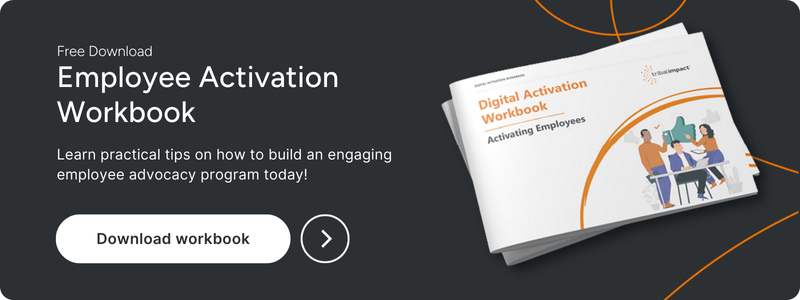Record numbers of people are quitting their jobs despite the current economic uncertainty. Which just shows that if people aren’t happy with their employer, they’re more willing to quit than ever.
According to the ONS, there were a record 1,247,000 job vacancies in January 2022. Meaning there are more job openings than there are unemployed people.
Businesses therefore need to work harder than ever to stand out to potential candidates and retain their existing employees.
One of the most effective, lowest-cost ways to do this is employee advocacy.
Employee advocacy is the shop window into a company’s culture. It offers a unique insight into what really happens at a company – without anyone even needing to talk about its culture, or maybe even the company, itself.
People are more trusting of employee-generated content than anything posted by a brand. They’re going to believe that content more clearly demonstrates what the culture is really like because it’s not marketing messages being reiterated by employees, or senior leadership talking about how great their business is.
So, the more advocates you have, the more it clearly demonstrates the company’s culture.
Employee advocacy is a truly powerful tool for businesses looking to attract – and retain – the very best talent. Let’s see how and why it’s so effective.
Shows A Culture Of Trust
When it comes to employee advocacy, there’s no way that you can check every single post before it goes live.
Instead, for it to really work, you have to learn to let go. You have to relinquish control and have faith that all the training you’ve done helps employees to understand what’s expected of them and what they should be doing.
This is a huge leap of faith that requires a great deal of trust between employees and employers. It just won’t work without that culture of trust and openness.
It is possible to use employee advocacy to build a culture of trust, but this can take longer and be harder to juggle as you’re changing people’s attitudes alongside training them in how to use social media as an advocate.
When you trust employees to create content, it shows that you believe in them and their knowledge. You know that when they talk about their job, they’re going to do it in a positive way that reflects well on the business and helps to build their brand as much as the company’s.
Introduces Your Culture
Because employees are posting about the business on social media, it introduces passive candidates to the company culture, too.
Employee-generated content offers a unique insight into how the business treats its employees, what’s expected of them, and what each role entails.
This can help to eliminate potential candidates who aren’t looking for roles that include advocacy, or otherwise don’t want to work for you.
It can also attract more of the right types of candidates; those who are going to be great advocates and are excited to work in a business with an open and trusting culture.
This can improve your time and cost to hire, because, when you’re ready to hire, candidates will already have a deeper understanding of the company’s culture and their role.
Employees don’t even need to talk about the culture for this to work. Since most businesses have blanket “don’t post on social media” social media policies, encouraging employees to share industry-related content immediately differentiates the workplace culture from that of other potential employers.
Gives Employees More Agency
Now, let’s talk about how employee advocacy helps you retain talent.
As we’ve mentioned, you can’t police every piece of content that’s published. Even if you suggest content for employees to share, you have no control over what they say when they add it to their timeline.
Which is good, because it means even if several employees share the same article, each version will have a unique, personal spin on it. So it won’t matter if the same person follows everyone who shares that post, because everyone will have different feelings about what the article says.
Employees will only feel comfortable sharing anything on social media if they feel like they have agency within their roles. Even if it’s content that the business suggests they post.
On the other hand, employees will be much less comfortable sharing content if they feel like they’re having their posts picked apart because someone dislikes the wording they’ve used or their content isn’t polished enough.
For advocacy to work, employees need to be given more control and trust in what they create.
Invests In Employees’ Skills
To get employee advocacy right, it requires training for both the employees and the people implementing the advocacy programme. This also requires change management practices to be put into place so that everyone knows what’s expected and they start to see social media differently.
Employees want to feel like their employer cares about them. Investing in their skills is one way to do this.
Builds Employees’ Confidence On Social Media
Some people are more comfortable posting on social media than others. An employee advocacy programme which trains employees in social media best practices allows them to feel more confident posting on social media because they know what they should and shouldn’t be doing.
Clear guidelines, as well as information on how to create content and engage with others, can build employees’ confidence on social media, turning lurkers into your best advocates and even making them thought leaders within the industry.
This may be slow going in some cases, as every employee will start at a different level. But if you find the people who are eager to take part and eager to learn, your advocacy programme will go from strength to strength.
Conclusion
Employee advocacy helps businesses to retain and attract talent in a variety of ways.
It helps to show company culture to a massive audience, even if you’re not yet ready to hire, or aren’t posting about the company itself. That means when you are ready to hire, you’ll already have passive candidates who are interested in working for the company.
Just the act of allowing employees to create content shows a culture of openness and trust that many businesses lack. This attracts employees who want to work for open and trusting companies, reducing time and cost to hire.
Investing in employees’ skills, and having an open culture, encourages employees to be themselves at work. They’ll also feel more comfortable and supported in their role, meaning they’ll be more likely to stay.

